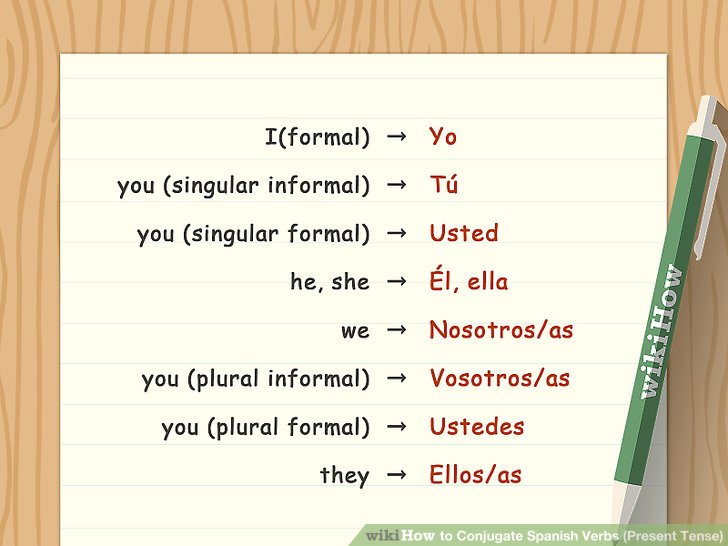Click to see all conjugation charts of vestir in every tense
In this conjugation lesson we will learn how to conjugate the verb vestir in the Presente tense of the Indicativo mood. It means we will see step by step how to create and translate forms of each grammatical person.
This lesson is specifically about the vestir conjugation. For a general overview of all the Simple Tenses conjugation check the Simple Tenses Conjugation Chart.
You may also see the Video Presentation on how to conjugate verbs in Presente. It’s embedded below, but using the above link you may get additional information on conjugation in this tense and explanation of exceptions and special cases.
How to translate Presente to English
Notice that the English phrases provided below next to each conjugation are not direct translations from Spanish to English. They are usually the closest general equivalents. The example differences are:- In Spanish conjugation, there is the form usted in the third person singular. But this person does not translate to the English third person singular. It translates to the so called formal you and uses the inflected form which is most often represented as he/she/it in English conjugation charts.
- Similar situation happens in the third person plural, where ustedes translates to the English plural formal you but uses the form which corresponds to the they form in English.
- Tenses are used differently in Spanish and English, so the actual translation should always take into account the context and focus on translating the meaning, not just words.
- In both languages each verb may have multiple meanings and not every meaning translates directly to the other language. Here also, the context and focusing on the particular meaning helps to create the most accurate translation.
The Spanish Presente de Indicativo tense translates to one of the following:
- The English Present tense, for example: nosotros vestimoswe dress
- The English Present Progressive (also called Present Continuous) tense, for example:en este momento vosotros vestís(plural) you are dressing at the moment
Note however, that the Spanish equivalent of the Present Progressive also exists and is in common use – that’s Presente Progresivo (a.k.a. Presente Continuo).
Note the timeline
The ability to properly locate the desired position on the timeline is a crucial skill for proper choice of tenses. So pay attention to the timeline in our lessons and visualize it while speaking, listening, writing and reading. After a bit practice you will be capable of selecting the right tense to use much easier.
Step by step instructions
Presente belongs to the simple tenses group, which means that all of the conjugated forms are one word long. There are also compound (compuesto) tenses in Spanish language, where each conjugated form consists of two words. The verb vestir has an irregular conjugation in the Presente tense of the Indicativo mood. The first person singular has an irregular stem in this tense.This verb belongs to the group which gets a change of the last e in the stem into an i.
It’s convenient to think about this change as happening only in:
- persons 1st, 2nd, 3rd singular and 3rd plural of Presente Indicativo
- 3rd person singular & plural of Pretérito Perfecto Simple
- Gerundio
The 1st person singular may also be entirely irregular here, and in such case it doesn’t follow this model. And when the first person of the Present tense is irregular, all the above mentioned tenses, which normally use the 3rd person’s form as the basis of their conjugation, use the 1st person’s form instead.
So in the regular stem vest change e to i to get vist. But at least the ending is regular for this person. It is -o as normally in the -ir verb group. Add it to the stem to get:
- yo visto – I dress
So as explained before we need to change e to i in the regular stem vest to get vist. And one more time the ending is regular for this person. It is -es as normally in the -ir verb group. Add it to the stem to get:
- tú vistes – you dress
So as explained previously we need to change e to i in the regular stem vest to get vist. And again the ending is regular for this person. It is -e as normally in the -ir verb group. Add it to the stem to get:
- él viste – he dresses
- ella viste – she dresses
- usted viste – (formal) you dress
- nosotros vestimos – we dress
- nosotras vestimos – (feminine) we dress
- vosotros vestís – (plural) you dress
- vosotras vestís – (feminine, plural) you dress
So as explained earlier we need to change e to i in the regular stem vest to get vist. Again the ending is regular for this person. It is -en as normally in the -ir verb group. Add it to the stem to get:
- ellos visten – they dress
- ellas visten – (feminine) they dress
- ustedes visten – (formal, plural) you dress
That’s it! The conjugation is now done. That’s the final result:
| yo | visto | I dress |
| tú | vistes | you dress |
| él/ella/usted | viste | he/she/it dresses |
| nosotros/nosotras | vestimos | we dress |
| vosotros/vosotras | vestís | you dress |
| ellos/ellas/ustedes | visten | they dress |
But do not end your session yet – it’s important to repeat and practice the material in order to remember it. Check below for next steps.
Next Steps to Perfection
|
Report a mistake | Give feedback
Thank you very much for making the effort to contact us!
We strive to provide the highest quality content and we greatly appreciate even the smallest suggestions:
We strive to provide the highest quality content and we greatly appreciate even the smallest suggestions:


